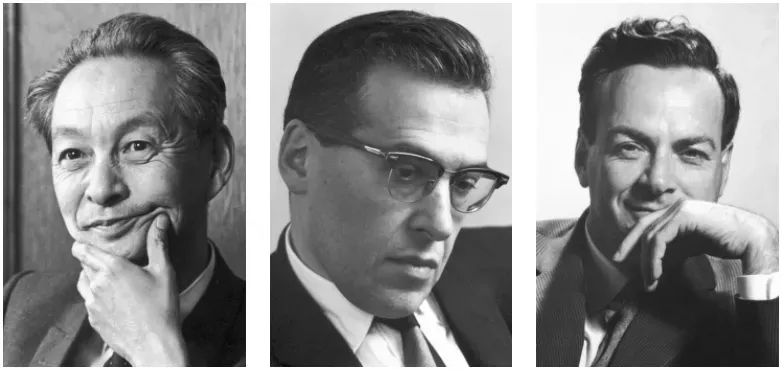The Strange Theory of Light and Matter
The Nobel Prize in Physics 1965: Sin-Itiro Tomonaga, Julian Schwinger, and Richard P. Feynman

The Nobel Prize in Physics 1965 is awarded jointly to Sin-Itiro Tomonaga, Julian Schwinger and Richard P. Feynman “for their fundamental work in quantum electrodynamics, with deep-ploughing consequences for the physics of elementary particles.”
QED is the theory that Richard Feynman got his Nobel Prize for, and he explains this eye-opening theory on his book QED: The Strange Theory of Light and Matter. The book starts by talking about the examples of light’s behavior from our daily lives to introduce the fact that physicists might observe how light behaves but they don’t know why light behaves that way. After mentioning the method that Feynman found to calculate the probability of the behavior of light, the book ends with explaining what Feynman is the most famous for — the Feynman Diagrams. QED stands for quantum electrodynamics, but I have another hypothesis, which I will tell you at the end of this story.
Whether photons are particles or waves has been a question that confused physicists’ minds for many years. Since the book is concerned about the interaction of light and matter, it is important to know the correct answer. Richard Feynman gives the answer very clearly.
“I want to emphasize that light comes in this form — particles. It is very important to know that light behaves like particles, especially for those of you who have gone to school, where you were probably told something about light behaving like waves. I’m telling you the way it does behave — like particles” (Feynman 15).
If you want proof, there is a thing called photomultiplier. A photomultiplier counts photons. You can’t count waves, but you can count particles.
What concerns us about light is how it behaves, because physicists always like to know why things happen, and to figure this out, they need to know how things happen. Some daily-life examples from light’s behavior is a good place to start observing light. We know that light gets reflected from a mirror with the same angle that it hits the mirror, light travels in a straight line, light bends when it passes through the water, light can be separated into different colors, and we can focus light with a lens.
From our observations, we know a lot about how light behaves. Now, we can think about why light behaves like this. Do you know who knows the answer? Well, not Richard Feynman. Unfortunately, I cannot tell you why light behaves the way it does because just like Feynman, I don’t know the answer as well.
“I am not going to explain how the photons actually “decide” whether to bounce back or go through; that is not known. (Probably the question has no meaning.) I will only show you how to calculate the correct probability that light will be reflected from glass of a given thickness, because that’s the only thing physicists know how to do!” (Feynman 24).
The concept of Causality might be helpful to understand what Feynman tries to say. Causality is the relationship between cause and effect. All dominos fall because you hit the first one. Can you imagine a single domino falling on its own, without a cause? No wind, no force, no friction or anything. I believe you can’t. Because you know that everything happens because of a cause. Before learning about quantum mechanics I was 99.9% sure that everything happening in our universe had a cause, but now, I am only 99 % sure, because there is something that makes me question causality, and here is it.
Consider an experiment in which you put a photomultiplier in front of a light source and another to the place that you expect the light to reflect through a piece of glass. A piece of glass passes through most of the light that hits it but some of the light is reflected. In fact, 96 % passed through and 4 % was reflected in this experiment. You probably don’t see any problem with this, but there is a problem. Imagine that you are a single photon. You came out of the light source and you hit the surface of the glass. What will you do? Will you go to the photomultiplier A or B? Statistically, you go to A 4% of the time and B 96% of the time, but why? What happens there? As I told you, we don’t know but we can at least know something else: we can know how much of the light would be reflected, 4%. And as far as the experiments show us, we can also know how much of the light will be reflected if we thicken the glass.
Here is how do we know it: we use arrows and stopwatches. We think of an imaginary clock. Every color of light has a clock hand rotating at a different speed. This clock represents the interval between the time that a photon is emitted from a light source to the time that it is detected by a photomultiplier. So, when a photon hits the photomultiplier, we stop the stopwatch and record the direction of the arrow. There is another rule, however. If the photon is reflected, we turn the arrow 180 degrees. You might feel lost as I am telling you about this because you don’t know why are we doing this. This is just a way to calculate how many of the photons will be reflected from the front surface of the glass, with a given thickness. This method does not give us any information about why a single photon chooses to go to A or B. After recording the direction of the arrows, we add them together as if we are doing a vector addition: tip to the tale. Finally, we take the square of the magnitude of our resultant vector, and this gives us the probability for a photon to be reflected or not. For this method, the magnitude of an arrow in a stopwatch is set to be 0.2. So, the most reflection we can get is 16% and the least is 0%. Since there is a stopwatch hand that follows a circular path, this method should give us a sinusoidal reflection outcome, and it does.
Knowing the method, would you expect to have the same probabilities for all colors using this method? Every color of light has a stopwatch that has different speeds. So, the probabilities change as the thickness of the glass changes, but the amplitude of the probability wave does not. This makes sense because the magnitude of the arrow that we use in this method is fixed. This also explains a thing from our daily lives. When the floor is wet and we look at the mud on the floor, we can see different colors of light being reflected from the ground. This is happening because not every part of the mud on the ground has the same thickness. Thinking about the mud on the floor, we can reach the conclusion that light does not only travel a single path but it travels every path possible. Since this is a very strong statement, I will get to it slowly with an experiment.
In the experiment above, we have a light source that will emit protons, a mirror that will reflect these photons, and a photomultiplier at a place that we expect the photons to hit. When we do this experiment, we see that light travels to hit the mirror with the same angle that it leaves the mirror. But, think about this: if the light traveled all of the paths, this would again be the outcome, because the probabilities of other paths would cancel out each other. This does not necessarily mean that light travels through every path, but it is consistent with the theory. Now, let’s prove that light travels through every path.

Here is a diffraction grating. Even though we don’t direct a source of light towards a diffraction grating, it can reflect different colors of light. A simple example of a diffraction grating is a compact disc! Remember that these arrows were showing the probabilities at the segments of a mirror. If we scrape or cover all of the arrows that point left, we prevent the probabilities from canceling out each other, and this results in a reflection, and this is how diffraction gratings work. In Feynman’s own words:
“Isn’t it wonderful! You can take a piece of a mirror where you didn’t expect any reflection, scrape away part of it, and it reflects!”
Finally, I will talk about the Feynman Diagrams, which I think why Richard Feynman is more famous than other physicists who got the Nobel prize for physics in the same year with him. Normally, in Quantum Mechanics there are very complex equations to show how electrons and light can interact with each other, but Feynman found a way to show these probabilities with a simple diagram. In these diagrams, the straight lines stand for electrons, or maybe anti-electrons, or any other particle and the wiggly lines stand for photons, as they behave like waves. Coupling is the event when an electron emits or receives a photon in the Feynman Diagrams. The diagram on the right shows how can two electrons interact with each other. One of them can emit a photon and change its direction in space due to the conservation of momentum, and the other can receive a photon to change direction, again because of the conservation of momentum. We know that photons don’t have mass but they do have momentum, so this is reasonable, but it is only one way that two electrons can interact.
Here are more diagrams that show other probabilities. As the number of couplings increases, the probability of that interaction happening decreases. So, the interaction below is very unlikely.
These Feynman Diagrams show possible ways that particles can interact, but we don’t know if anything like this happens or not, because we can’t find a cause for these to happen. The thing is these calculations just work. In fact, they work very well. Considering more probabilities, scientists now calculated the magnetic moment of an electron with very little uncertainty, thanks to the theory of quantum electrodynamics.
Do you remember my promise from the beginning? I want to tell my hypothesis about the name QED, quantum electrodynamics. QED also stands for Quod Erat Demonstrandum, meaning “that which was to be demonstrated” in Latin. This phrase is usually used at the end of proofs in mathematics, so I believe that the name was chosen to be QED to make a pun.
Source
Feynman, Richard. QED: The Strange Theory of Light and Matter. Princeton University Press, 2019.





